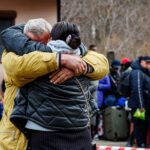Background: While a large proportion of conflict-affected populations have been dually exposed to trauma and loss, there is inadequate research identifying differential symptom profiles related to bereavement and trauma exposure in these groups. The objective of this study were to (1) determine whether there are distinct classes of posttraumatic stress disorder (PTSD) and prolonged grief disorder (PGD) symptoms in bereaved trauma survivors exposed to conflict and persecution, and (2) examine whether particular types of refugee experiences and stressors differentially predict symptom profiles. Methods: Participants were 248 Mandaean adult refugees who were assessed at an average of 4.3 years since entering Australia following persecution in Iraq. PTSD, PGD, trauma exposure, adjustment difficulties since relocation, and English proficiency were measured. Latent class analysis was used to elucidate symptom profiles of PTSD and PGD in this sample. Results: Latent class analysis revealed four classes of participants: a combined PTSD/PGD class (16%), a predominantly PTSD class (25%), a predominantly PGD class (16%), and a resilient class (43%). Whereas membership in the PTSD/PGD class was predicted by exposure to traumatic loss, those in the PGD class were more likely to have experienced adaptation difficulties since relocation, and individuals in the PTSD class were more likely to have experienced difficulties related to loss of culture and support. Conclusions: This study provides evidence that specific symptom patterns emerge following exposure to mass trauma and loss. These profiles are associated with distinct types of traumatic experiences and post-migration living difficulties. These results have substantial public health implications for assessment and intervention following mass trauma.
The management of volunteers – What can human resources do? A review and research agenda
There is an increasing interest from scholars and practitioners in understanding how non-profit organizations can design and implement human resources (HR) practices to enhance desirable volunteer attitudes and behaviors. This paper presents a comprehensive overview of existing studies on the relationship between HR practices and volunteering outcomes. We use the ability-motivation-opportunity model as a guiding…

